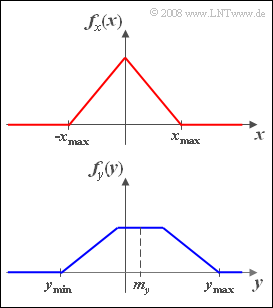Difference between revisions of "Aufgaben:Exercise 4.7Z: Generation of a Joint PDF"
From LNTwww
m (Guenter moved page Exercise 4.7Z: Generation of a "2D-PDF" to Exercise 4.7Z: Generation of a two-dimensional PDF) |
m (Guenter moved page Exercise 4.7Z: Generation of a two-dimensional PDF to Exercise 4.7Z: Generation of a joint PDF) |
(No difference)
| |
Revision as of 13:40, 25 February 2022
Given statistically independent quantities $u$ and $v$, both of which are uniformly distributed between $-1$ and $+1$ and thus each have variance $\sigma^2 = 2/3$ , generate a 2D random variable $(x, y)$ where for the components:
- $$x = A \cdot u + B \cdot v + C,$$
- $$y= D \cdot u + E \cdot v + F.$$
The 2D–random variable $(x, y)$ to be generated should have the following statistical properties:
- Let the variances be $\sigma_x^2 = 4$ and $\sigma_y^2 = 10$.
- Let the random variable $x$ be mean-free $(m_x =0)$.
- For the mean of $y$ let $m_y = 1$ hold.
- The correlation coefficient between $x$ and $y$ is $\rho_{xy} = \sqrt{0.9} = 0.949.$
- The random variable $x$ possess a triangular PDF $f_x(x)$ corresponding to the above graph.
- The random variable $y$ has a trapezoidal PDF $f_y(y)$ according to the lower graph.
Hints:
- The exercise belongs to the chapter Linear Combinations of Random Variables.
- In particular, reference is made to the page [Theory_of_Stochastic_Signals/Linear_Combinations_of_Random_Variables#Generation_of_correlated_random_variables|Generation of correlated random variables]].
- To avoid ambiguity, it is specified that all coefficients $A$, ... , $F$ should be non-negative.
Questions
Solution
(1) Given the mean values given, it must hold:
- $$ C = m_x\hspace{0.15cm}\underline{ = 0},$$
- $$ F = m_y\hspace{0.15cm}\underline{ = 1}.$$
(2) Taking into account $\sigma^2 = 2/3$ holds:
- $$\sigma_x^2 = \sigma^2 \cdot ( A^2 + B^2)= {2}/{3} \cdot ( A^2 + B^2) .$$
- Because $\sigma_x^2 = 4$ it follows $A^2 + B^2= 6$.
- A triangular PDF means that $A = \pm B$ must hold.
- Thus, since negative coefficients have been excluded, we obtain:
- $$ A = B = \sqrt{3}\hspace{0.15cm}\underline{ = 1.732}.$$
(3) With $ A = B = \sqrt{3}$ corresponding to the last subtask, two equations of determination remain for $D$ and $E$:
- $$\sigma_y^2 = \sigma^2 \cdot ( D^2 + E^2)= 10 \hspace{0.5cm} \Rightarrow \hspace{0.5cm} D^2 + E^2 = \frac {\sigma_y^2}{\sigma^2} = \frac {10}{2/3} \stackrel{!}{=}15,$$
- $$\rho_{xy} = \frac{A \cdot D + B \cdot E}{\sqrt{(A^2 + B^2)(D^2 + E^2)}} = \frac{\sqrt{3} \cdot (D + E)}{\sqrt{6 \cdot (D^2 + E^2)}} \stackrel{!}{=} \sqrt{0.9}.$$
- From this it further follows: $D + E = \sqrt{1.8 \cdot ( D^2 + E^2)} = \sqrt{27} = 3 \cdot \sqrt{3}.$
- The equation, in conjunction with $D^2 + E^2 = 15$ and the constraint $(D>E)$ leads to the result:
- $$ D= 2 \cdot \sqrt{3}\hspace{0.15cm}\underline{ = 3.464}, \hspace{0.5cm}E= \sqrt{3} \hspace{0.15cm}\underline{= 1.732}.$$
(4) The random variables $x$ and $y$ respectively, take their maximum values when respectively $u= +1$ and $v= +1$ holds:
- $$ x_\text{max}= A+B \hspace{0.15cm}\underline{ = +3.464}, \hspace{0.5cm} x_\text{min} = - A - B= -3.464.$$
- $$ y_\text{max}= D+E+F \hspace{0.15cm}\underline{ = +6.196}, \hspace{0.5cm} y_\text{min} = -D-E+F= -4.196.$$

